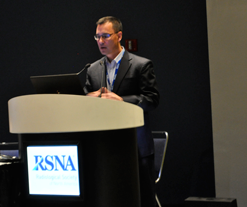 UW is a nationwide leader in microwave ablation, thanks to the efforts of the
UW is a nationwide leader in microwave ablation, thanks to the efforts of the
Tumor Ablation Lab. Led by Fred. T. Lee Jr, M.D., and Christopher Brace, Ph.D., the lab has produced full-fledged ablation systems, dozens of patents, and a spinoff company called Neuwave Medical. Dr. Lee shared the insights gained from years of developing and performing MW ablations, in a talk entitled “The Case for Microwave Ablation.”
UW Health mostly uses microwave ablation due to its excellent ability to stop tumor growth, speed, and ease of use. While microwave and radiofrequency ablation are quite similar, there are a few differences. Microwave ablation is agnostic to tissue, meaning the energy spreads equally through different types of tissue. Lee also noted that the term “microwave ablation” is misleading, as microwaves are still within the RF spectrum. “Instead, I like to think of it as an advanced radiofrequency system,” said Lee.
Perhaps the most interesting feature of microwave ablation is the shrinkage described by Dr. Lee. Microwave ablation heats the tissue to over 60 degrees Celsius in order to melt phospholipids, a major component of cell membranes. When the tissue near the probe is heated to these high temperatures, it pulls taut around the probe, pulling the tumor inwards. This phenomena is a byproduct of microwave ablation, and it wasn’t immediately noticeable. While Dr. Lee was creating his presentation, he went through his old studies to gather relevant information, and noticed the shrinkage effect for the first time on a 7-year-old video. An unintended positive side effect, like this shrinkage, is a rare and exciting find in medicine.
Microwave ablation also has cost and time advantages over other modalities. Dr. Lee estimated that microwave ablation cost $270,000 less than cryoablation over a period of 120 procedures, and that doesn’t even take into account the time saved by physicians. Additionally, microwave ablation requires significantly less equipment than cryoablation, saving on what Dr. Lee calls the “hassle factor.”
While all modalities of ablation can be successful, UW prefers microwave ablation because of the tumor control, speed, and simplicity. As the Tumor Ablation Lab continues to generate new techniques and devices, Dr. Lee will continue to lead the way.
Join the conversation on Twitter @UWiscRadiology, #RSNA15